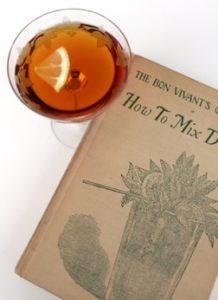Dan Priseman recently ran a blind tasting of 9 classic Martinez recipes following feedback from his previous article on this classic coktail, here he gives you details on his findings.
Since March, when I first wrote about the Martinez cocktail on my website bitters&twisted I’ve had a lot of bartenders ask me which recipe is the best.
That’s a loaded question of course, because as with any drink it comes down to the unique ingredients used and the skill of the person making the drink as to how any particular recipe tastes. That being said with a drink that has seen so many incarnations over the past 128 years, yet is widely known by only one simple version, it seemed to me that it would be interesting to put the recipes head-to-head in an attempt to better understand the amazing Martinez cocktail.

I hoped that by blind tasting all the unique recipes that I uncovered while researching the Martinez that a clear picture would form about how the drink evolved and how it may have been enjoyed in the past.
For those that haven’t read my original post I encourage you to do so before reading the rest of this article, but if you don’t have time, or are too lazy, below is a brief summary of the history of the Martinez as well as some thoughts about how it may have been enjoyed in the past.
History of the Martinez
It’s fair to say that no one knows for certain who invented the Martinez, or how he or she intended the drink to be served. What we can do however, is base its history on is the written recipes recorded in cocktail book through the years.
The most striking thing about the Martinez is that you can walk into most good bars and order one and be served a drink made to roughly a standard recipe. The Martinez is understood by most bartenders to be two parts sweet vermouth to one part gin, with a dash of bitters and a splash of maraschino liqueur. Yet looking back at the recipes from the past, many use dry vermouth instead of sweet, curacao often replaces the maraschino and orange bitters were often used in place of aromatic.
It is pure conjecture as to how we have arrived at a modern understanding of this drink that differs so distinctly from many of the past versions, but it occurs to me that the version we use today is strikingly similar (or identical) to the version released in the 1887 edition of Jerry Thomas’, Bon Vivant’s Companion.
Many bartenders over the years have turned to this book as a starting point to understanding classic cocktails, so it makes sense to me that this may have influenced our current understanding of the drink.
The first recorded recipe that I have found is from 1884 from three years prior to the Jerry Thomas reference though, and in it O H Byron compares the drink to the Manhattan, only made with gin. His book goes on to give two recipes for the Manhattan, one using dry and one using sweet vermouth.
Is it possible that in its early history the Martinez was a drink that could be ordered either sweet or dry?
It seems a distinct possibility to me, especially when you consider the ingredients used in it, being Old Tom Gin (sweeter than our modern dry gins) with the addition of sweet liqueur. To balance the sweetness of those two ingredients surely dry vermouth might work well?
Blind Tasting

So with these thoughts in mind I decided that a blind tasting would be the best way to try to understand the complexities of the history of this wonderful cocktail. I’ll admit that I was quietly hoping that one of the recipes with dry vermouth would prove popular, so to guarantee that I couldn’t influence the outcome I decided to ensure that even I didn’t know which drink was which during the tasting.
Richard Wynne, the owner of the fabulous Callooh Callay in Shoreditch, agreed to co-host the tasting event with me in his bar. I pre-made all the recipes in batches and put them in the fridge and then later Richard served them in a random order (obviously keeping track so that we could unravel it all later). Complicated I know, but the system seemed a fair way of ensuring that the session was completely unbiased.
All that was left was to assemble a group of tasters willing to sip their way through nine different versions of the Martinez and offer their thoughts on each one. I asked only one thing of this elite group of guinea pigs, and that was that they all suspend any pre conceived ideas of what a Martinez should taste like, and instead focus on the merits and balance of ingredients in each drink they tried.
I was lucky enough to secure the services of Sarah Mitchell and Adam Smithson, the founders of Juniper society and experts in the field of all things gin related, Emma Stokes, the infamous Gin Monkey, Adam Elmegirab who not only produces Boker’s, the bitters used in some of the recipes, but also helped with my original research into the history of the Martinez.
Joining them to ensure a balanced group of tasters was Sarah Christmas, the other half of my blog bitters&twisted, Simon Webster of BarLifeUK, and two willing consumers with a taste for gin cocktails, Christina and Sophie.
For the sake of those who don’t have all day to read about every individual recipe tasted and the thoughts of our tasting panel, I won’t review each one here. If you do want to read more however there is a full write up on bitters&twisted which you might find of interest.
Instead here I want to focus on the discussion that happened after all nine recipes were tasted and of course reveal which recipes came out on top and why.
Tasting Notes
The one thing that everybody agreed was that the tasting threw out a lot of surprises and that perhaps the Martinez isn’t just the straightforward sweet vermouth and gin concoction that we know so well today. There is a lot of diversity within the historical recipes and actually they were all unique and interesting drinks.
Having asked everyone to pick their top three from the tasting, I found it interesting that every single recipe got at least one vote. It was interesting to hear die hard ‘classic’ Martinez fans suddenly talking about the great balance in versions using dry vermouth, or saying that some of the sweet vermouth versions were too sweet and rich.
The general consensus was that the Martinez should perhaps, as per the first written recipe, be considered in a similar way to the Manhattan, with flexibility as to the style of vermouth used.
It was also agreed that this is especially important when considering which gin you are using for your Martinez. On the night we used Ransom Old Tom Gin, Hammer & Son Old English Gin, Beefeater, Plymouth and Beefeater 24 in the various recipes, and all of them struck a balance when used in the right recipe.
Another thing that I am keen to point out is that this tasting proved absolutely nothing conclusive in terms of finding the ultimate Martinez recipe. I guess that was never the point, but it’s safe to say that as with all cocktails if you change one of the ingredients, so for example used Martini extra dry instead of Noilly Prat, then the balance of the drink changes.
The point for me was to see if the Martinez should be looked at as a style of drink (much as the Martini or Manhattan is) instead of a definitive cocktail with only one unique recipe.

The results of the tasting certainly surprised most people in the room and led to much discussion about offering customers more than one option when the words ‘can I have a Martinez please’ are uttered across the bar. So without further waffling from me here are the top three picks from the night, all of which scored well with only three points separating them.
The Results
3rd place – the 1934 recipe from Patrick Duffy’s, Official Mixers Manual and also appearing in 1700 Cocktails for the Man Behind the Bar in the same year – a recipe designed to serve six people, but scaled down here for those who want just one. 45ml dry vermouth, 45ml Plymouth Gin, 2 dashes orange bitters and a barspoon of curacao or maraschino (I chose maraschino).
The general consensus was that this was a light and refreshing version of the drink, and while not what most people would recognize as a Martinez was certainly well-balanced and enjoyable to drink. Some considered it to be closer to a (very) wet Martini, almost a missing link between the two drinks that places an emphasis on the vermouth and offers a nice touch of sweetness as well.
2nd place – the classic 1887 recipe from Jerry Thomas and what most people today would recognize as a Martinez. 60ml sweet vermouth, 30ml Old Tom (or in this case Old English) Gin, 2 dashes maraschino, 1 dash Boker’s bitters.
As you might expect this was considered by many to be a well-balanced cocktail, but several of the tasting panel mentioned that the gin was hidden and the vermouth was the star of the show. My personal favourite comment was that the drink was just a touch too sweet, a little too bitter with a bit too much maraschino and was just TOO CLASSIC. Talk about nailing it. Overall it was considered to be a great drink and everyone agreed that it has become a classic for a reason.
1st place – the surprise winner on the night was the dry vermouth recipe taken from O H Byron in 1884, and the first Martinez recipe to appear in a cocktail book as far as we know. The original recipe was for a small drink containing 30ml dry vermouth, 15ml Old Tom Gin (I used Ransom), 3-4 dashes of Angostura bitters and 3 dashes of gomme.
This was the only recipe that all of the tasters chose in their top three, and reading through the comments it was found to be rich, spicy with dark fruit notes. Most people commented on the long finish and the fact that this recipe left you wanting to take another sip. Almost everyone also mentioned that the balance in this drink was the best of the night and that this version tasted like a classic cocktail with simple ingredients combining to become more than the sum of their parts.
So there you have it, three very different recipes for the Martinez, all of which shone through in the blind tasting as being excellent drinks that are well worth trying.
It was unsurprising to find the classic version from Jerry Thomas coming through as one of the best, but I think that most people in the room on the night were surprised that a Martinez made with dry vermouth came out on top. It just goes to show that perhaps we shouldn’t assume we know how a classic should be served and should be open to new (or maybe old?) ideas.
In the case of the Martinez, I now look at it as a family of drinks that showcase vermouth balanced with gin and bitters, and I’m open to trying it either dry or sweet. A couple of months ago the idea of a dry Martinez would have had me rolling my eyes, but now it doesn’t seem quite so absurd.
We’re never likely to know how the first ever Martinez cocktail was made, but one thing is certain, the recipes throughout the ages have been diverse and interesting, and while I’m sure Jerry Thomas’ version will remain the standard, maybe a few of you will experiment with dry versions too. You never know, it just might catch on.
If you want to read more about all nine of the recipes we tried, then please check out the article here on bitters&twisted.

